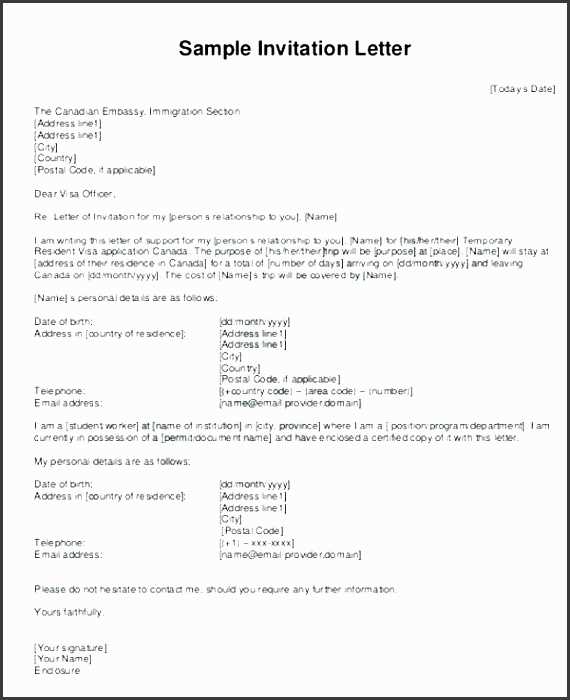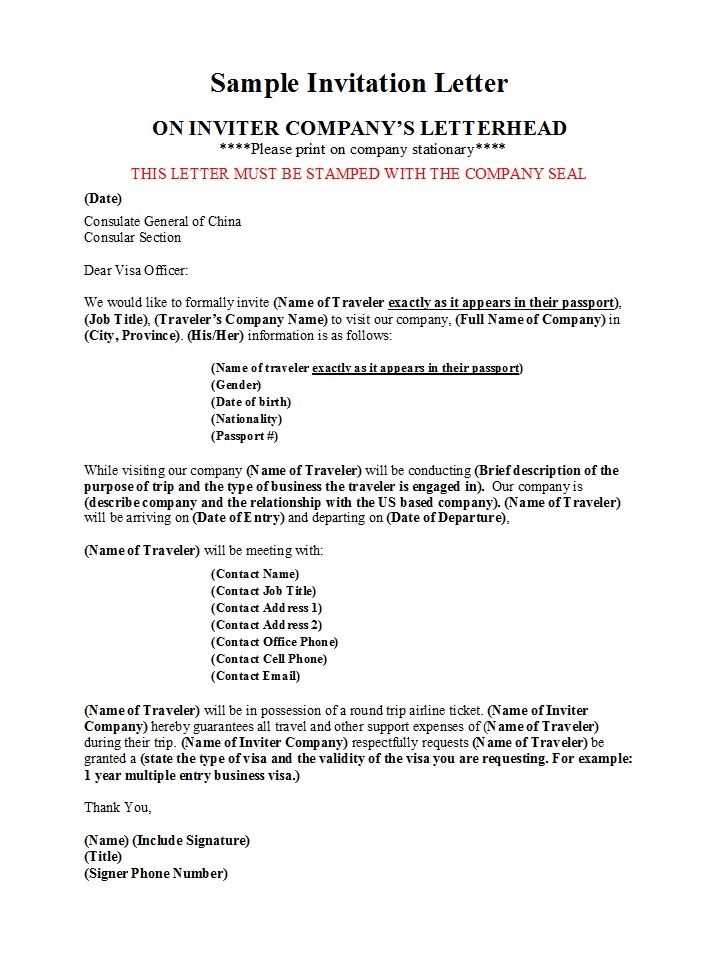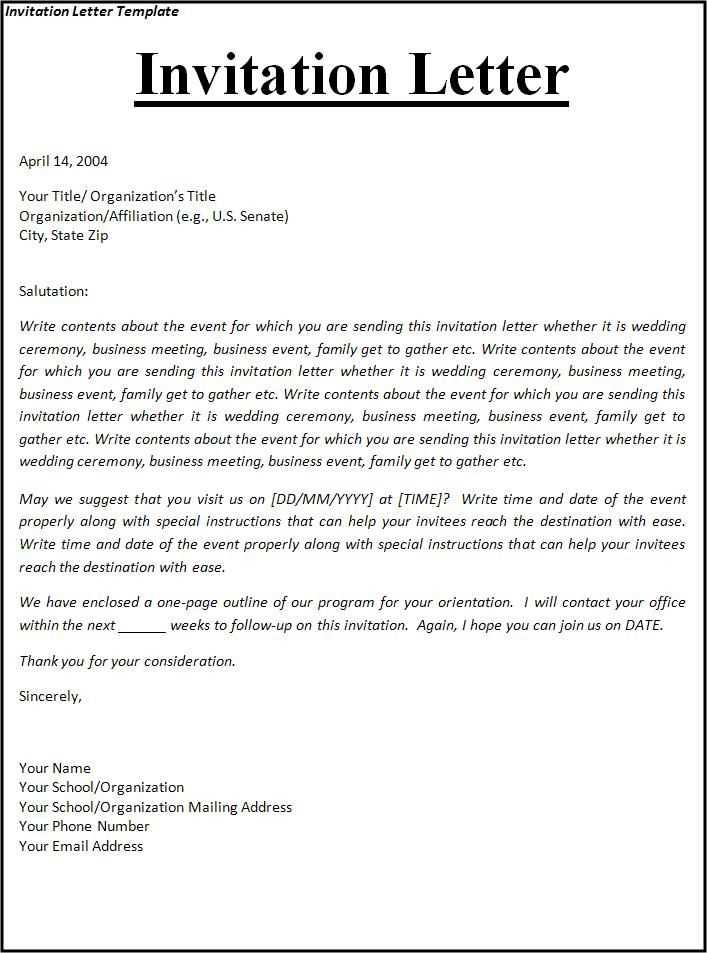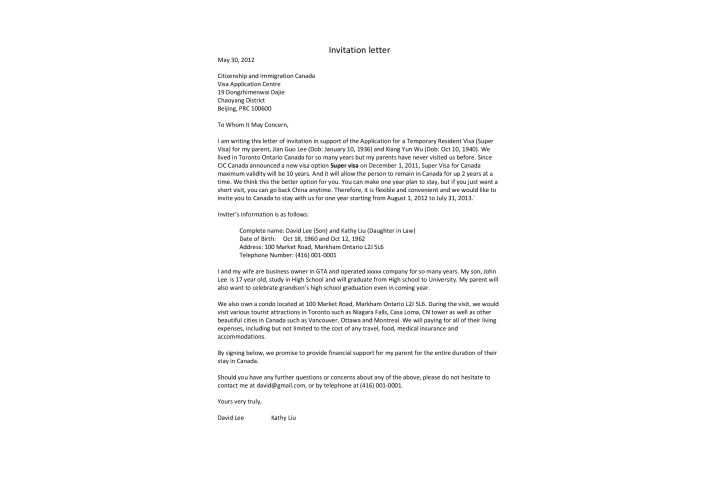Invitation letter template canada

Creating an invitation letter for a visitor visa to Canada is straightforward, but it’s important to follow a specific format and include all necessary details. A well-structured invitation letter can significantly increase the chances of visa approval. Here’s a guide on how to craft an effective invitation letter.
First, ensure that the letter includes the full name, address, and contact information of both the inviting person and the invitee. The invitation should clearly state the purpose of the visit and the duration of the stay. Be sure to mention any plans or events during the visit, such as family gatherings or tourism.
Include proof of relationship: It’s essential to explain the nature of your relationship with the invitee, whether they are a friend, relative, or business associate. If applicable, mention any previous visits to Canada or other countries.
Specify financial support: If you are financially supporting the visitor, state this clearly. Mention how the visitor’s expenses will be covered, whether through your funds or their own. Attach proof of your financial stability, such as bank statements or pay slips, to further support the application.
End the letter by expressing your willingness to provide further details if needed. Remember, the goal is to make the application process as smooth as possible for the invitee while ensuring all required information is present.
Invitation Letter Template for Canada
When preparing an invitation letter for someone visiting Canada, ensure it includes all necessary details. Start with your full name, address, and contact information. State your relationship with the visitor and the purpose of their trip. Clearly mention the dates of their visit and where they will stay. It’s important to provide details on who will bear the financial responsibility, whether it’s you or the visitor. Include your status in Canada, whether you are a citizen, permanent resident, or temporary resident.
Next, state that you will ensure the visitor will return to their home country at the end of the visit, and mention any specific travel arrangements if applicable. The letter should be signed by you with a date, and if possible, notarized. This shows authenticity and strengthens the application.
Double-check for clarity and completeness before submitting the letter to avoid delays in the visa application process.
How to Structure an Invitation for Canada Visa
Begin the invitation letter by clearly stating your name, address, and citizenship status. Include your relationship to the applicant, such as friend, relative, or business associate. This establishes your role and purpose for inviting them.
Next, provide specific details about the person you’re inviting. Include their full name, date of birth, nationality, and passport number. You should also mention the purpose of their visit, whether it’s tourism, attending a family event, or conducting business.
Clearly outline the dates of the visit. Specify the arrival and departure dates and mention where the visitor will stay. This could be your home or a hotel, depending on the situation. If you are hosting the visitor, include your complete address and details about the accommodation arrangements.
It is also necessary to clarify your financial responsibility for the visitor’s stay. If you’re sponsoring their trip, state that you will cover all costs, including travel, accommodation, food, and other expenses. Provide proof of your ability to do so, such as bank statements or pay slips, if required by the visa authorities.
Lastly, affirm your commitment to ensure the visitor returns to their home country by the end of their stay. A short statement confirming that the visitor has the intention to return after the visit is necessary to avoid any misunderstanding.
Key Details to Include in a Canadian Invitation

When writing an invitation letter for a Canadian visa, make sure to include specific details that support the purpose of the visit and clarify the host’s responsibilities. Here’s what you should mention:
- Host Information: Include the full name, address, phone number, and relationship to the guest. It’s crucial that the host is a Canadian citizen or permanent resident.
- Visitor Information: Provide the guest’s full name, date of birth, passport details, and reason for the visit. Clarify the dates and duration of stay.
- Purpose of Visit: Clearly state why the visitor is coming to Canada (e.g., tourism, family visit, business). Provide specifics to support the claim.
- Accommodation Details: Mention where the guest will stay. If the host is providing accommodation, state this explicitly.
- Financial Support: Indicate whether the host will cover the visitor’s expenses or if the guest will be financially responsible. Attach supporting documents, like bank statements or employment letters, if applicable.
- Invitation Validity: Include specific dates when the invitation is valid. This will give immigration authorities a clear timeline for the visitor’s stay.
- Host’s Signature: The invitation must be signed by the host to confirm authenticity. If applicable, provide copies of supporting documents like the host’s Canadian ID or residency status.
Ensure all these details are accurate and clear to avoid any issues during the application process. Double-check the information before submitting to make sure everything aligns with the visa requirements.
Common Errors to Avoid When Writing an Invitation for Canada

Double-check your details to avoid common mistakes. Missing or incorrect personal information can delay processing or lead to rejections. Ensure that the name, address, and passport number of both the inviter and the invitee are accurate and match official records.
1. Lack of Clarity in the Purpose of Visit
Be explicit about the purpose of the visit. Whether it’s for tourism, family reunion, or business, avoid vague statements. Outline specific dates, events, or activities that demonstrate why the visit is necessary and planned.
2. Missing Required Supporting Documents
Failure to provide the necessary documents can result in the refusal of the invitation. Include financial proof, accommodation details, and any relevant official documents. Missing documents may also cause delays in the visa process.
3. Not Including Detailed Contact Information
Provide full contact details, including the inviter’s phone number, email, and mailing address. Make it easy for the authorities to contact you for clarification or additional information. Without this, the invitation may be deemed incomplete.
4. Incorrect Relationship Details
If you’re inviting a family member, make sure to clearly define your relationship. Misunderstanding of family ties can lead to confusion. For example, specifying whether the person is your spouse, parent, or sibling is necessary to validate the claim.
5. Overlooking Financial Responsibilities
Clearly state your financial responsibility for the guest’s stay if applicable. If you are sponsoring the visitor, explain how you will cover their expenses. Forgetting this step can raise doubts about the legitimacy of the invitation.
6. Ambiguous Travel Dates
Provide specific dates for the guest’s arrival and departure. Open-ended or indefinite stays will create doubts about the nature of the visit and may lead to rejection. Make sure the dates align with the purpose of the trip.
7. Failing to Follow Format Requirements
Ensure that your invitation follows the correct format and adheres to the guidelines set by Canadian immigration authorities. Failure to do so may lead to unnecessary delays in processing the visa application.
8. Misrepresenting Information
Be truthful about all information presented in the invitation. Misleading or incorrect details can have serious consequences, including a permanent ban from inviting others to Canada. Always double-check for accuracy.
| Common Errors | How to Avoid Them |
|---|---|
| Lack of Clarity in Purpose | Be specific about the visit’s purpose and provide clear dates and activities. |
| Missing Documents | Ensure all required documents are included with the invitation letter. |
| Incorrect Relationship Details | Define your relationship with the invitee accurately. |
| Unclear Financial Responsibility | State your financial responsibilities for the guest’s stay. |
| Ambiguous Travel Dates | Include exact arrival and departure dates for the visitor. |
How to Personalize Your Invitation for Specific Needs
Tailor your invitation by addressing the specific purpose and requirements of the invitee. Consider the nature of their visit–whether it’s for tourism, business, or a family visit–and adapt your tone and details accordingly. If inviting a business associate, highlight professional details like the purpose of the meeting, scheduled dates, and expectations. For a family member or friend, mention personal connections, shared plans, or how their visit will contribute to your life.
Adjust the Language and Content for Your Invitee
Adjust the formality level based on the relationship you have with the recipient. A formal tone is best for business or professional purposes, while a more casual, warm tone works for family or friends. For example, for a colleague or business partner, use clear, concise language focusing on the meeting’s goals and timeline. On the other hand, for family or close friends, include personal touches, such as mentioning shared memories or activities you’ve planned together.
Include Specific Details for Visa Purposes
Always ensure that your invitation includes key details needed for visa applications. Include clear travel dates, accommodation details, and your relationship with the invitee. Specify the duration of stay and ensure the purpose of their visit is crystal clear, as immigration authorities may request further clarification. Personalize these sections based on whether the visitor will stay in your home, a hotel, or elsewhere.
By tailoring the content of the invitation to the nature of the visit and the individual, you not only make the letter more relevant but also enhance the chances of it being accepted and processed smoothly by authorities.
How to Address Various Visitor Types in Your Invitation

When drafting an invitation letter for different visitor types, customize the tone and details to fit their purpose of visit. A personalized approach shows attention to the unique relationship and visa requirements of each visitor.
For Family Members
If you are inviting family members, clearly state the nature of your relationship with them. Include their full names, the purpose of the visit, and how long they will stay. Highlight their ties to their home country to strengthen the visa application. For example: “I am inviting my parents, John and Jane Doe, to visit me for a family reunion in Canada. They will stay with me from June 1 to June 30, 2025.”
For Business Associates or Colleagues
For business visitors, be specific about the professional relationship. Mention the event, meetings, or collaborations they will participate in, and indicate the duration of their stay. Providing details about the company or event can help the visa officer assess the purpose of the visit. Example: “I am inviting my colleague, Michael Smith, to attend a business seminar in Toronto. He will be here from March 10 to March 15, 2025, to discuss potential collaborations between our companies.”
For Friends
When inviting friends, focus on the social aspects of the visit. Mention how long you’ve known each other, and explain why they are visiting. Be sure to include plans for the visit and offer reassurance regarding their intent to return. Example: “I am inviting my friend, Sarah Lee, who I’ve known for 10 years, to spend two weeks with me in Canada. She will stay from May 5 to May 19, 2025, during her vacation.”
Legal Considerations When Crafting an Invitation for Canada
When drafting an invitation letter for a visitor visa to Canada, it is critical to be aware of the legal implications that come with the process. The letter should be clear, accurate, and specific, as inaccuracies could jeopardize the applicant’s visa approval. Below are key points to keep in mind:
1. Financial Responsibility
- Ensure that the inviter clearly states their financial ability to support the guest during their stay. This includes covering travel, accommodation, and living expenses if necessary.
- Provide supporting documents, such as pay stubs, bank statements, or tax returns, to verify the financial support mentioned in the invitation.
2. Legal Status of the Inviter
- The inviter must be a Canadian citizen or permanent resident. If the inviter is a temporary resident, the visa applicant might face complications.
- Clearly state the inviter’s status in Canada, providing relevant documentation such as a copy of a Canadian passport, permanent resident card, or work permit.
3. Purpose of Visit
- Clearly define the purpose of the visit, such as tourism, family visit, or business, to avoid any misrepresentation.
- Ensure the visitor’s intentions align with the legal grounds for a temporary stay under Canadian immigration laws.
4. Length of Stay
- Specify the exact duration of the visit. The visitor’s stay should not exceed the allowed time frame granted by the Canadian immigration authorities.
- Ensure that the invitee does not overstay their visa, as this can result in severe consequences, including a future ban from Canada.
5. Potential Risks
- Understand that inviting someone to Canada holds the responsibility for their actions while on Canadian soil. If the visitor overstays or violates Canadian laws, it could affect the inviter’s future immigration status.
- The inviter may be held accountable for the visitor’s legal and financial obligations during their stay.